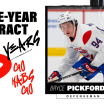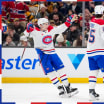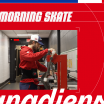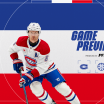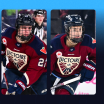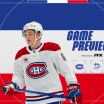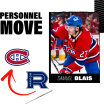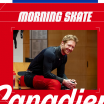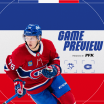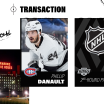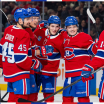MONTREAL - Marc Bergevin has met with the media a few times over the offseason, after trading for Max Domi, adding 11 new prospects to the organization's depth chart at the NHL Draft, and bringing longtime Habs centerman Tomas Plekanec back home on the first day of free agency, but the Habs' GM wanted to give fans their chance, too.
Canadiens mailbag with Marc Bergevin
Habs GM Marc Bergevin answers fan questions from social media
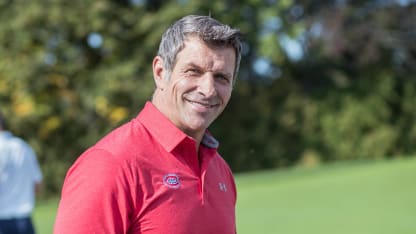
By
Shauna Denis @CanadiensMTL / canadiens.com
While he wasn't able to answer the hundreds of questions that poured in via social media, he did take some time to shed some light on a few key topics from injury updates and player development to how an NHL trade actually goes down.
Editor's note: some questions have been edited for grammar or length or translated from their original language.]***
**Question from [@HabsChronicle via Twitter
How do you plan on managing all the players on the roster currently? By our estimation, there are about 27 that could be on the team, but there are only 23 spots.
MARC BERGEVIN: Well, for starters, we have a few injured guys on the roster and with some of them, we're not sure if they're going to be ready for camp or even the start of the regular season, so that gives us some space to work with. Then we'll look at internal competition. Whoever earns a job at camp will get to stay.
Question from @TheEagleDares via Twitter
Marc, how do you respond to major events that may hamper your long-term plans for the team? Example: Carey Price's injury a few years ago. Do you have contingencies already built-in or is it more of a calculated response based on each situation?
MB: When it comes to your top-end guys, they can't be replaced. Carey is one example, but you saw what happened with LA a few years ago when they lost Jonathan Quick or when Tampa lost Steven Stamkos. You can't have someone waiting on the sidelines to replace an elite player at that level. But injuries are part of the game so whenever someone goes down, you have to look internally first and that's where having good depth is really important.
Question from @bshah79 via Twitter
Wouldn't having Jesperi] Kotkaniemi in Montreal & Laval versus Assat allow the organization have more control/oversight on his development and is that the preferred plan this upcoming season?**
**MB:** Jesperi was just here at our development camp in June so we had an opportunity to watch him closely after the Draft. The next step is that he'll come to our training camp in September and we'll evaluate him then and see where he fits. You have to remember that he's still a really young player. He just turned 18 years old, so to force him into a spot where he would be exposed isn't going to be good for him in the long term and we're not going to do that. We'll make a decision based on what we see during camp. He'll either play in Montreal, or if he's that far off, he might as well go back to Pori to continue his development in Finland. That's a strong league.
**Question from [@MarkColdwell via Twitter
What are determining factors in where a player plays after being drafted? This question is kind of tied to but not directly targeted at Kotkaniemi. Like, he will play in Laval if? He will play in Europe if? He will play in NHL if? Is player input a factor at all? What's the process?
MB: Some guys have contracts with teams in other leagues in Russia or Finland or Sweden, and usually these kids are only 18 years old. With second- and third-round guys, they usually aren't quite ready yet - that's something we saw with Artturi Lehkonen and Jacob de la Rose early on, where they went back to play with their teams in Europe for a few years to develop over there. It's a bit different with NCAA players, because there are different rules you have to follow so the players can maintain their NCAA eligibility. Ryan Poehling, for example, can come to our development camp, but he can't come to the main camp. The only way college guys can come to Montreal is if we sign them - which means they are no longer eligible to play in the NCAA - so in Poehling's case, he could potentially join us at the end of the year when his college season is done.
Question from @roy996633 via Twitter
Mr. Bergevin, if a player like Kotkaniemi or Poehling shows you at camp that he's ready to play in the NHL, would you do everything you could to make room for him on the team and give him a real chance? Thanks. #GoHabsGo
MB: Like I mentioned, Poehling can't be at camp because we haven't signed him, but if Kotkaniemi shows up and he earns a spot in Montreal, he'll stay with us.
Question from @chile\_pepper via Twitter
Marc, how do you find internally that the team, which today is highly similar to the group from last season, has had an attitude adjustment sufficient to tackle next year?
Oh and can you update us on Paul Byron, Andrew Shaw and Shea Weber's recoveries from surgery?
MB:Last year, from top to bottom, a lot of guys played under par. That was unpredictable. Some top guys had a really tough start and it was a bit of a chain reaction from there. That will be a big difference this year. When those guys come in and they play the way we know they can, you'll see that shift in confidence throughout the team and it will translate on the ice. I expect them to come into camp ready to go and if they do, this team will be better from the start. In terms of updates on recovery time, we gave
an update on Weber already
. Byron is on target and may be even a little ahead of schedule - I'll really stress the "maybe" there though - but it's going well. Shaw is on target, too. They want to come back quicker and they're working hard to recover over the summer.
Question from @j\_ajram via Twitter
Why no offer sheets on any centerman? What do you have to lose?
MB: It's not really that you have anything to lose but there are some things to consider. First of all, the centerman you want has to be available, and then second, his team can't have enough cap space to match your offer. And remember, you have to give up draft picks to match the size of the offer. It could be three first-round picks you end up giving up. That's a big price to pay. The more money you offer, the more picks you have to give up.
Question from @sholi2000 via Twitter
I'm successful in life because I made a lot of mistakes early. What have you learned since 2012, your most important lesson? #INeverGiveUpGoHabsGo
MB: Good question. I kind of knew this already, but the biggest thing is that if you want elite players - especially centermen, who are really hard to get - you have to draft them. You're not going to get them through free agency. It happened this year with John Tavares, obviously, but that's once every 10 years or so where a guy like him picks where he wants to go. You really need to draft players and take time to develop them. You won't bat a thousand when you draft, but you realize how important the draft is to your organization. The other thing is that when you do well, you draft further back and the chance you'll get a franchise player late in the first round is pretty rare.
Question from @creststorm via Twitter
With what the Vegas Golden Knights accomplished this past year in the NHL, does that make you and other GMs take a harder look at talent that's "not quite ready"? Do you believe those players were underestimated, and maybe big stars are overvalued in today's NHL? #GoHabsGo
MB: To me, the biggest thing about Vegas was that it was a lot of guys who had something to prove. They had no egos, and they played for themselves. Look at William Karlsson. He scored 43 goals last year, but I think he went something like 47 games without a goal in 2016-17. Jarmo Kekalainen is not a dumb GM. Maybe it was a question of opportunity or just a change in scenery, I don't know, but sometimes things just don't click with one team, and then a guy goes somewhere else and it works. The other thing is how this expansion draft worked. Teams either had to give up high picks or good players to protect other good players. The landscape was different than it was for other expansion drafts.
Question from @BobbyJoeAudet via Twitter
Could you shed a little light on how trade talks between GMs start and what is said generally? Does it start with a text? How do you announce that a player is available? How do other GMs know that someone is available? Thanks!
MB: It could be a text or a phone call. It's not usually an email. There are different ways to start it - guys don't usually like to commit right away. Everybody is a little careful before they start throwing names around. A typical conversation would be, "Are you thinking of doing anything?" "What are you looking for?" "I might be able to move this guy if…" The odd time a guy will tell you who's available, but it's rare. You have to get to know the other general managers and how they like to work, too. Some want to get right to the point; others will dance around a little. That's something you don't really get to see until you're sitting in the GM chair. I saw it a bit in Chicago as assistant GM], but, you're near the conversation not in the conversation. You need to be in those conversations to really understand how other GMs like to operate.
**Question from [@RealRGM81 via Twitter
Mr. Bergevin, it is great to see the Canadiens committed to building through the draft. What key steps do you feel the organization should take to ensure strong development so our young players can maximize their potential and excel at the NHL level? #GoHabsGo
MB:* We have processes in place already and we've been adding resources over the offseason. Joel Bouchard will be great with our prospects in Laval, and we've got a strong development staff internally.
The development question is interesting, because at the end of the day, there are a lot of examples you can point to around the League where a guy didn't reach his full potential with an NHL team for a variety of reasons. Remember, when you draft a kid, you project three, four, five years down the road. You do your homework and you collect as much information as you can, but a lot of things can happen. The most you can do is give your young players the tools they need - and I believe every team in the NHL does that - and then they need to do the work to develop.
Question from @lascelle3232 via Twitter
What would you say is currently the Canadiens' biggest strength and what is the team's biggest weakness?
MB: Obviously, we know we have work to do down the middle, but with what we have coming down the pipeline with Kotkaniemi, Poehling, 2018 second-round pick] Jacob Olofsson and a few others, we think that's going to be a strength for us in the future. Right now, I think our biggest strength is in net with Carey Price. He's one of the best goaltenders in the League.
**Question from [Devin Paine via Facebook
Which prospect in the Habs pipeline do you think is the most underrated? Which player should the fans watch out for at training camp this year?
MB:** These kids are really young, so to tell you that Samuel Houde is going to make an impression at training camp is a long shot, but I really liked what I saw from him during development camp. We're looking maybe two or three years down the road for him. As far as training camp, Kotkaniemi will be the one to watch. We've also got some great college players who aren't allowed to be at camp, like Poehling and Jordan Harris, but you should keep an eye on them with their respective teams this year.

